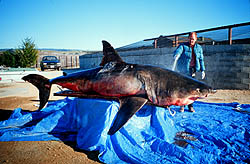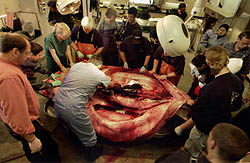
February 12, 2001
Great white shark attracts attention at Long Marine Lab
By Tim Stephens
Marine scientists don't get many opportunities to dissect a great white shark, so
members of the local research community jumped at the chance recently to examine
a 14-foot, 1,700-pound specimen of this awesome predator. Researchers conducted a
postmortem examination (called a necropsy) of the shark last month at the California
Department of Fish and Game facility next to Long Marine Laboratory.
 |
| It took a few days for the 1,700-pound great white shark to thaw out in preparation for a postmortem examination at the California Department of Fish and Game facility next to Long Marine Lab. Hosing down the shark is campus veterinarian Dave Casper. Photo: Jim MacKenzie |
 |
| Shark expert David Ebert (back to camera) explores the interior of a great white shark as UCSC veterinarian Dave Casper (left, foreground) and other researchers look on. Photo: Darryl Bush, Chronicle/Pelagic Shark Research Foundation |
 |
| Samantha Chie, a student in a Pelagic Shark Research Foundation course, holds the shark's heart. Photo: S. Van Sommeran, Pelagic Shark Research Foundation |
Shark expert David Ebert, a co-owner of U.S. Abalone in Davenport, performed the necropsy. Ebert earned his Ph.D. working with one of the world's foremost shark experts, Leonard Compagno, at the Shark Research Center in Capetown, South Africa, and he's had plenty of experience examining great white sharks.
This shark was a female about 12 years old and did not appear to be reproductively mature, Ebert said. "We're still waiting for the results from lab studies of the reproductive tract, but it seemed to be in late adolescence," he said. "It's never been pinned down when the females mature, but I don't believe this one was quite there yet."
The fact that many sharks, including great white sharks, are slow-growing and mature late in life is one reason their populations must be protected, he noted.
The shark was caught accidentally last November by a fisherman working out of Morro Bay. Tangled in a halibut gill net, the shark wrecked the fisherman's gear in its death throes. Although great white sharks are a protected species which cannot legally be hunted or sold, the law allows a commercial fisherman to sell a shark to recover the cost of damaged fishing gear. So a friend of the fisherman posted the shark on e-Bay, the online auction house, and before long the bidding climbed into the thousands of dollars.
But the fisherman had already been contacted by Sean Van Sommeran, executive director of the Pelagic Shark Research Foundation, who hoped to obtain the shark for research. Van Sommeran persuaded the fisherman to foresake the high bids and let science benefit from his catch. He paid the fisherman $700 and the shark was his.
But what do you do with a 14-foot, 1,700-pound shark carcass? The only place on the coast with a freezer big enough to store such a catch, and a lab that could accommodate the necropsy, is the CDFG's Marine Wildlife Veterinary Care and Research Center at Long Marine Lab. Casper contacted the center's director, Dave Jessup, who volunteered his facilities for the project. The shark rode up from Morro Bay on a flatbed truck.
During the necropsy, researchers made detailed measurements and took tissue samples for further study. The shark's gut was empty, so researchers were not able to learn anything about its diet. Some interesting parasites were found on the shark's body and were sent to a specialist on the East Coast for further identification, Ebert said.
"We obtained a lot of information that will be useful for comparison with other specimens," Ebert said.
The shark's head went back into the freezer to be kept for further dissection at a later date.